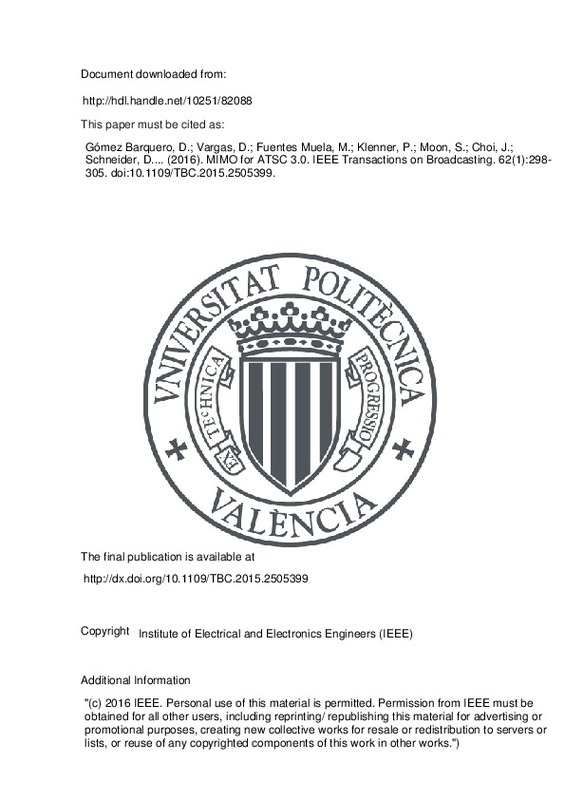JavaScript is disabled for your browser. Some features of this site may not work without it.
Buscar en RiuNet
Listar
Mi cuenta
Estadísticas
Ayuda RiuNet
Admin. UPV
MIMO for ATSC 3.0
Mostrar el registro sencillo del ítem
Ficheros en el ítem
| dc.contributor.author | Gómez Barquero, David
|
es_ES |
| dc.contributor.author | Vargas, David
|
es_ES |
| dc.contributor.author | Fuentes Muela, Manuel
|
es_ES |
| dc.contributor.author | Klenner, Peter
|
es_ES |
| dc.contributor.author | Moon, Sangchul
|
es_ES |
| dc.contributor.author | Choi, Jin-Yong
|
es_ES |
| dc.contributor.author | Schneider, Daniel
|
es_ES |
| dc.contributor.author | Murayama, Kenichi
|
es_ES |
| dc.date.accessioned | 2017-05-31T10:47:03Z | |
| dc.date.available | 2017-05-31T10:47:03Z | |
| dc.date.issued | 2016-03 | |
| dc.identifier.issn | 0018-9316 | |
| dc.identifier.uri | http://hdl.handle.net/10251/82088 | |
| dc.description | "(c) 2016 IEEE. Personal use of this material is permitted. Permission from IEEE must be obtained for all other users, including reprinting/ republishing this material for advertising or promotional purposes, creating new collective works for resale or redistribution to servers or lists, or reuse of any copyrighted components of this work in other works.") | es_ES |
| dc.description.abstract | This paper provides an overview of the optional MIMO (Multiple-Input Multiple-Output) antenna scheme adopted in ATSC 3.0 to improve robustness or increase capacity via additional spatial diversity and multiplexing by sending two data streams in a single radio frequency channel. Although it is not directly specified, it is expected in practice to use cross-polarized 2x2 MIMO (i.e., horizontal and vertical polarization) to retain multiplexing capabilities in line-of-sight conditions. MIMO allows overcoming the channel capacity limit of single antenna wireless communications in a given channel bandwidth without any increase in the total transmission power. But in the U.S. MIMO can actually provide a larger comparative gain because it would be allowed to increase the total transmit power, by transmitting the nominal transmit power in each polarization. Hence, in addition to the MIMO gains (array, diversity and spatial multiplexing), MIMO could exploit an additional 3 dB power gain. The MIMO scheme adopted in ATSC 3.0 re-uses the SISO (Single-Input Single-Output) antenna baseline constellations, and hence it introduces the use of MIMO with non-uniform constellations. | es_ES |
| dc.language | Inglés | es_ES |
| dc.publisher | Institute of Electrical and Electronics Engineers (IEEE) | es_ES |
| dc.relation.ispartof | IEEE Transactions on Broadcasting | es_ES |
| dc.rights | Reserva de todos los derechos | es_ES |
| dc.subject | ATSC 3.0 | es_ES |
| dc.subject | MIMO | es_ES |
| dc.subject | DTT | es_ES |
| dc.subject | Spatial multiplexing | es_ES |
| dc.subject.classification | TEORIA DE LA SEÑAL Y COMUNICACIONES | es_ES |
| dc.title | MIMO for ATSC 3.0 | es_ES |
| dc.type | Artículo | es_ES |
| dc.identifier.doi | 10.1109/TBC.2015.2505399 | |
| dc.rights.accessRights | Abierto | es_ES |
| dc.contributor.affiliation | Universitat Politècnica de València. Instituto Universitario de Telecomunicación y Aplicaciones Multimedia - Institut Universitari de Telecomunicacions i Aplicacions Multimèdia | es_ES |
| dc.description.bibliographicCitation | Gómez Barquero, D.; Vargas, D.; Fuentes Muela, M.; Klenner, P.; Moon, S.; Choi, J.; Schneider, D.... (2016). MIMO for ATSC 3.0. IEEE Transactions on Broadcasting. 62(1):298-305. doi:10.1109/TBC.2015.2505399 | es_ES |
| dc.description.accrualMethod | S | es_ES |
| dc.relation.publisherversion | http://dx.doi.org/10.1109/TBC.2015.2505399 | es_ES |
| dc.description.upvformatpinicio | 298 | es_ES |
| dc.description.upvformatpfin | 305 | es_ES |
| dc.type.version | info:eu-repo/semantics/publishedVersion | es_ES |
| dc.description.volume | 62 | es_ES |
| dc.description.issue | 1 | es_ES |
| dc.relation.senia | 307290 | es_ES |







![[Cerrado]](/themes/UPV/images/candado.png)

